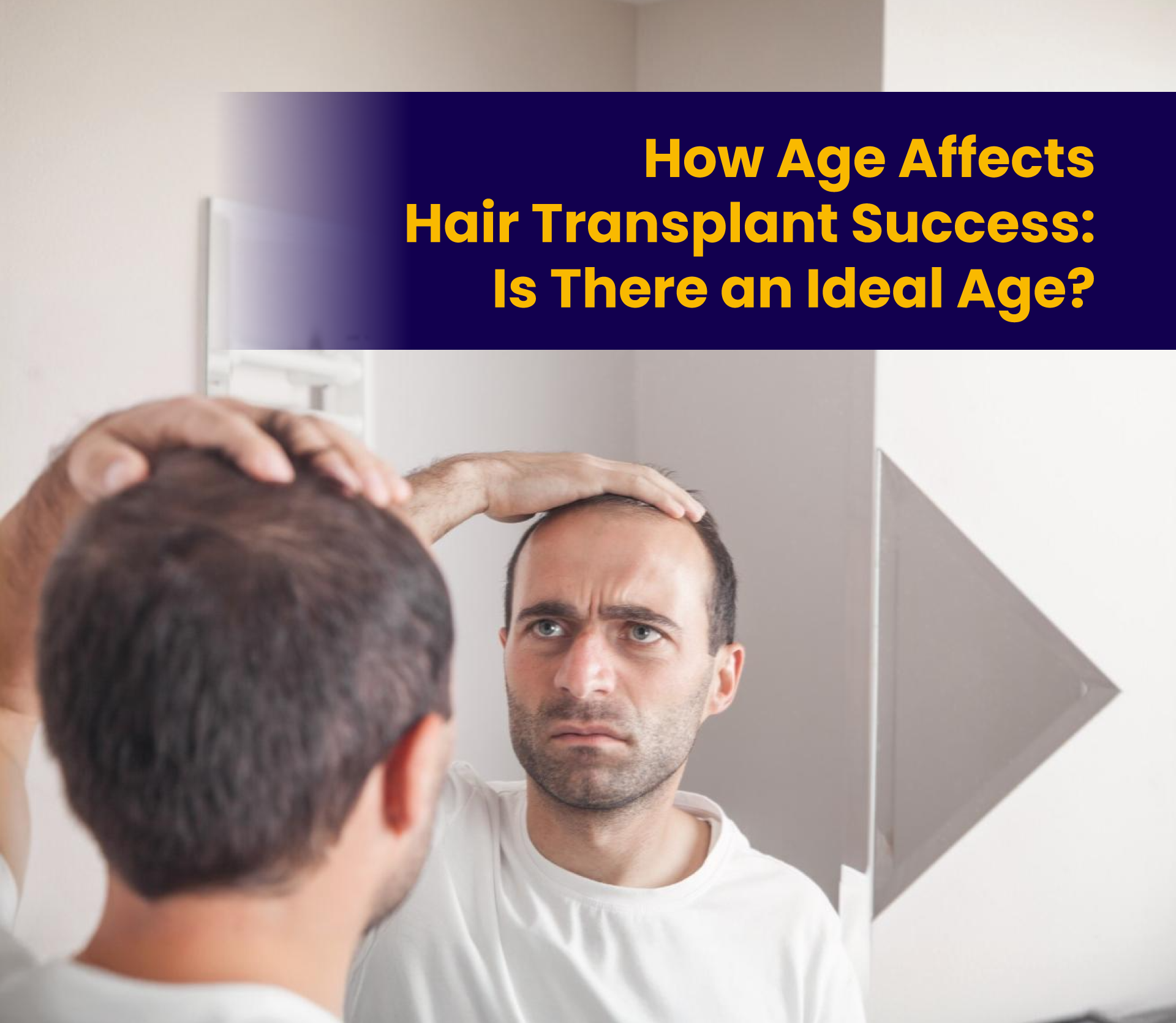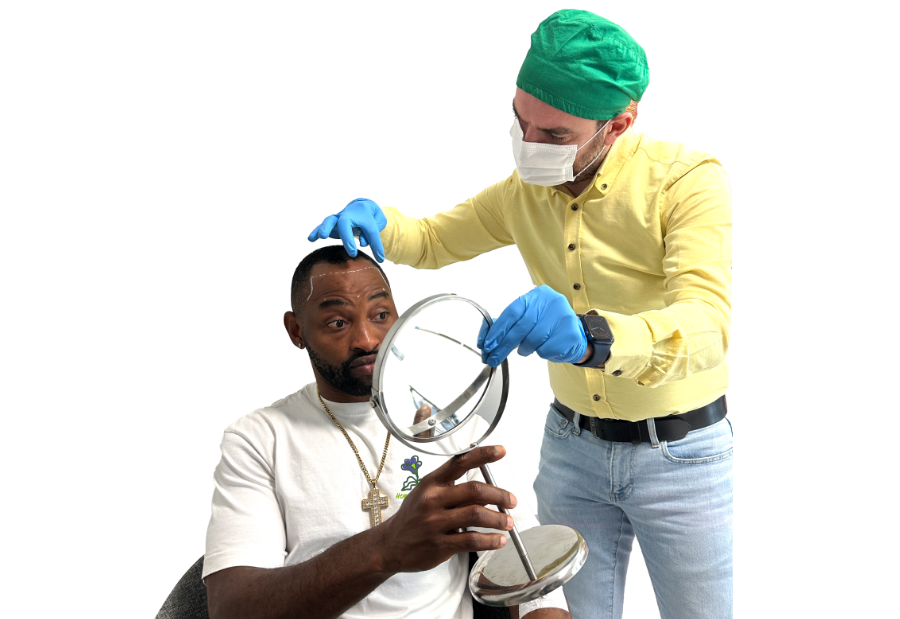Get 25% OFF Hair Transplant Packages This New Year — Book Today!
How Age Affects Hair Transplant Success: Is There an Ideal Age?

Introduction
Hair loss can strike at any age, but the decision to undergo a hair transplant isn’t as simple as spotting a thinning hairline. Many wonder if there’s a best age for hair transplant procedures or whether timing plays a real role in the results. People are likely overwhelmed with advice regarding hair restoration with so much data available. Some people begin considering their options in their 20s, while others are still waiting until their 40s or older. The reality is, age is just one part of a much bigger question. To make the right decision, you have to look at the big picture, including how your hair behaves in different stages and what the science says about potential outcomes.
Understanding Hair Loss Patterns Across Different Ages
Common Hair Loss Stages in Younger Adults
Hair thinning in younger adults, especially in men, tends to start in young adulthood, usually in the early to mid twenties. This is usually hereditary and hormonal and, most often, progressive, following the classic male pattern baldness. While the tendency is to sometimes rush into a transplant, it is not always as straightforward as signing up for a transplant assessment today. Hair loss at this stage is often still progressing, which means newly transplanted hair could look unnatural as surrounding native hair continues to thin.
Hair Thinning and Loss in Middle Age
By the time people reach their 30s and 40s, their pattern of hair loss becomes more predictable. This is often seen as the best age for hair transplants, which is why hair transplants at 30 are quite popular. At this age, surgeons can better plan for long-term results since future hair loss becomes easier to forecast. The donor area is usually well-developed, and patients are often better prepared, emotionally and financially, for the procedure.
Hair Loss Trends in Seniors
Hair loss in individuals over 50 tends to become more extensive. However, not everyone in this age group is a poor candidate. While some may wonder when it is too late for a hair transplant, age alone doesn’t disqualify someone. Many older adults have benefited from transplants when their scalp health, donor hair quality, and general health supported the procedure.
The Science Behind Age and Hair Transplant Outcomes
How Age Influences Hair Follicle Quality
Younger individuals typically have more active hair follicles and better hair density. However, this advantage can be misleading. If the hair loss pattern is still changing, early transplants might require revisions later. On the other hand, those in their 30s and 40s usually have stable hair loss patterns, and the quality of donor follicles remains high, making it the best age for hair transplants.
Scalp Elasticity and Healing Capacity Over Time
Scalp flexibility plays an important role in transplant success. Younger scalps tend to be more elastic, making it easier to perform follicle grafting. Healing is also quicker. With age, the scalp loses some of its flexibility and the healing process may slow down. This doesn’t necessarily mean poor outcomes, but it can affect how quickly results appear and how easily the skin accepts grafts.
Ideal Age Range for Hair Transplants: Fact vs Myth
Why Early 20s May Be Too Soon for Some Candidates
Many ask, “Is hair transplant in one’s 20s safe?” The answer depends on how advanced the hair loss is. While early procedures can work, many specialists advise waiting. The hairline may continue receding even after the transplant, leading to uneven results. A better strategy could involve medical management first to stabilize hair loss before considering surgery.
Advantages of Undergoing Transplants in Late 20s to 40s
This age range is often considered the best age for hair transplants. Hair loss has usually stabilised, making it easier to predict long-term patterns. Donor hair is still strong, and the patient is often in good overall health. A hair transplant at 30 or in the mid-30s strikes a good balance between youth and predictability.
Is There a Cutoff Age for Hair Transplants?
There’s no hard limit on when someone should stop considering a transplant. What matters more is scalp condition, donor hair quality, and overall health. So, when is it too late for a hair transplant? Technically, there’s no definite age. Instead, a personalised consultation will determine if it’s safe and effective for someone in their 50s or even 60s.
Here is things to know before a hair transplant
Factors Beyond Age That Impact Transplant Success
Overall Health and Medical Conditions
Good health is key to a successful transplant. Chronic conditions like uncontrolled diabetes or skin disorders can affect healing. Medications may also impact how your scalp responds. Regardless of your hair transplant age, your general well-being is always a major consideration.
Hair Density and Donor Area Quality
Even a perfect candidate on paper won’t see great results without a strong donor area. Surgeons look for thick, healthy hair at the back and sides of the scalp. The denser this area, the better the outcome. Hair density matters more than age in many cases.
Realistic Expectations and Psychological Readiness
Patients must be mentally prepared. They should understand that results take time, and perfection is rarely achievable in one session. This emotional maturity often comes with age, making a hair transplant at 30 or older more likely to result in satisfaction.
Case Studies: Success Stories Across Different Age Groups
Young Adult Transplant Success
One male patient underwent a transplant at 24 after his hairline stabilised through medication for a few years. With careful planning and follow-up treatments, he achieved a natural look that has aged well.
Middle-Aged Patient Outcomes
A 38-year-old female experienced hair thinning after childbirth and stress. She opted for a transplant once her hormone levels balanced. Results were dense and long-lasting, with minimal touch-ups needed.
Older Adults Who Achieved Great Results
At 58, a man decided to restore his crown area. Despite mild health issues, his donor hair was excellent. With proper post-op care, he regained a fuller look and boosted his confidence without complications.
The dramatic change in appearance when comparing Elon Musk before plastic surgery to his current look has sparked curiosity among fans.
Tips for Choosing the Right Time for Your Hair Transplant
Consulting with a Specialist for Personalized Advice
No matter your age, expert advice matters. A consultation with a qualified hair transplant specialist will help you understand your options. They can assess your hair loss pattern, donor area, and health to recommend the best course of action.
Monitoring Hair Loss Progression Before Deciding
Before you act, keep track of your hair loss over time. If it’s progressing fast, a specialist might suggest delaying surgery. Taking the time to understand your pattern helps you avoid premature decisions and achieve better results.
Also here is the detailed guide for when to get a hair transplant
Conclusion: Age Is One of Many Factors for Hair Transplant Success
Age plays a role in hair transplant planning, but it’s not the only factor. The quality of your donor hair, overall health, and how stable your hair loss is will shape the results far more. So if you’re wondering when you should get a hair transplant, don’t look at the calendar alone. The right time is when your scalp, health, and expectations all align. Work with a trusted professional, and you’ll have the best chance at long-term success.

